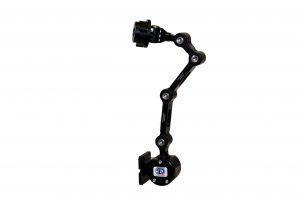Maintaining Head Support Position – let’s do the math!
Michelle L. Lange, OTR/L, ABDA, ATP/SMS
I see a lot of clients for head positioning in their wheelchair seating system. This requires a thorough seating assessment, as well as providing the best product. Even if I choose what I believe to be the very best head support for a client, I find that maintaining the position of that support is a challenge. I continually find that the hardware has moved, often resulting in a sub-optimal head position for the client.
 According to Greg Peek, president of Seating Dynamics, “it is generally accepted that the old style headrest hardware using a ball and socket does not stay in place. It slips and moves – the more you tighten it, the more it moves. There have been many attempts to improve on it with different methods of clamping, but with little success.” Greg’s solution was to eliminate the part that doesn’t work, the ball and socket and replace it with a multiple disc finger joint, offering a very large surface area to clamp and hold.
According to Greg Peek, president of Seating Dynamics, “it is generally accepted that the old style headrest hardware using a ball and socket does not stay in place. It slips and moves – the more you tighten it, the more it moves. There have been many attempts to improve on it with different methods of clamping, but with little success.” Greg’s solution was to eliminate the part that doesn’t work, the ball and socket and replace it with a multiple disc finger joint, offering a very large surface area to clamp and hold.
Greg Peek loves to design the indestructible. After all, we see some tough clients! He has designed mounting joints for Dynamic Head Supports that provide a large degree of adjustment while maintaining position. To fully appreciate how this works, we have to look at some math (sorry about that).
Rigidity and resistance to joint slippage is a function of clamping surface area.
| Clamping area of three different joints | Square Inches | Percentage of 1″ Ball |
|---|---|---|
| 1″ diameter ball w/ shaft collar clamping | 1.5707 | 100.00% |
| Cone style | 0.523 | 33.30% |
| Seating Dynamics Finger Joint | 5.478 | 348.76% |
Now I’m not an engineer. So, what do all those numbers mean? Well, the more surface contact there is, the less likely the joint is to slip. Seating Dynamic’s hardware has over 3 times the surface area contact as a traditional ball and socket, so it holds it’s position.
Efficiency has to do with the use of space and volume – a ratio of the clamping area compared to the size or volume that the joint hardware consumes in space.
| Volume of Joint Cubic Inches | Space Efficiency Ratio | Volume Comparison | |
|---|---|---|---|
| 1″ diameter ball | 2.404 | 1.531 | 100.00% |
| Cone style | 1.050 | 0.498 | 43.68% |
| Seating Dynamics Finger Joint | 1.428 | 3.835 | 59.41% |
The cone style is 43% the size of the standard 1” diameter ball and has 1/3 of the clamping area, so it doesn’t maintain it’s position as well. The Seating Dynamics finger joint is 59% the size of the standard 1” ball, yet has 3.48 times the clamping area, allowing this hardware to maintain its position very well. Even the design of Head Support Mounting Hardware can determine whether a client can maintain head alignment.
Are you working with clients whose head support is constantly moved out of position? Seating Dynamics Dynamic Head Support Hardware design can maintain alignment of the head support by increasing the clamping area. Our Dynamic Head Support Hardware also absorbs client forces, which keeps head support components in alignment and prevents breakage, as well as client injury.

Thanks for the detailed comparison of hardware options for head support on difficult clients. Very useful.
Thanks Missy, I hope it helps you out!